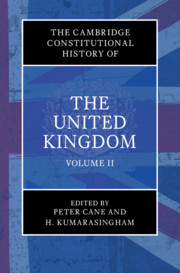Book contents
- The Cambridge Constitutional History of the United Kingdom
- The Cambridge Constitutional History of the United Kingdom
- Copyright page
- Contents
- Contributors
- Editors’ Preface
- 1 The Kingdoms of Anglo-Saxon England (450–1066)
- 2 England after the Conquest
- 3 England in the Thirteenth Century
- 4 England in the Fourteenth Century
- 5 England in the Fifteenth Century
- 6 England in the Sixteenth Century
- 7 The English Constitution in the Seventeenth Century
- 8 A European Perspective
- 9 Wales before Annexation
- 10 The Scottish Constitution before 1707
- 11 The Eighteenth-Century Constitution
- 12 The Constitutional and Parliamentary History of Ireland till the Union
- 13 The United Kingdom in the Nineteenth Century
- 14 The United Kingdom in the Twentieth Century
- 15 The Twenty-First-Century Constitution
- 16 Wales since the Annexation
- 17 Scotland in the Union
- 18 Ireland in the Union
- 19 The Making of Empire
- 20 Constitution and Empire
- Index
16 - Wales since the Annexation
Published online by Cambridge University Press: 12 August 2023
- The Cambridge Constitutional History of the United Kingdom
- The Cambridge Constitutional History of the United Kingdom
- Copyright page
- Contents
- Contributors
- Editors’ Preface
- 1 The Kingdoms of Anglo-Saxon England (450–1066)
- 2 England after the Conquest
- 3 England in the Thirteenth Century
- 4 England in the Fourteenth Century
- 5 England in the Fifteenth Century
- 6 England in the Sixteenth Century
- 7 The English Constitution in the Seventeenth Century
- 8 A European Perspective
- 9 Wales before Annexation
- 10 The Scottish Constitution before 1707
- 11 The Eighteenth-Century Constitution
- 12 The Constitutional and Parliamentary History of Ireland till the Union
- 13 The United Kingdom in the Nineteenth Century
- 14 The United Kingdom in the Twentieth Century
- 15 The Twenty-First-Century Constitution
- 16 Wales since the Annexation
- 17 Scotland in the Union
- 18 Ireland in the Union
- 19 The Making of Empire
- 20 Constitution and Empire
- Index
Summary
‘For Wales – see England’. For much of the period since the Annexation of 1284, the constitutional history of Wales might be summed up neatly in this oft-quoted, and rather dismissive, line from the Encyclopaedia Britannica.1 Edward I’s settlement set the parameters within which Wales was to operate in terms of government, the administration of the law and the role of the Church, for 250 years; and the so-called ‘Act of Union’ (1536 and 1543) carried the process further, assimilating governmental and legal practice in Wales further to the English model. Yet, as this chapter will suggest, ‘For Wales – see England’ does not tell the full story of Wales’s constitutional history. During the nineteenth century, as a viable strain of political nationalism grew up in the principality, its proponents looked to the example of Ireland as a pattern on which to model their demands. During the twentieth, it was Scotland that provided the inspiration for politicians now anxious for a greater measure of devolution – something finally achieved in 1997. If the first five centuries after annexation saw Wales sublimated to English constitutional imperatives, the nineteenth and the twentieth saw Wales define its own nationhood by active engagement with the other smaller nations within the United Kingdom. In this chapter these three phases of Welsh constitutional development will be examined in turn, and it will be suggested that the Wales which received a degree of institutional independence in 1997 was a very British creation.
- Type
- Chapter
- Information
- The Cambridge Constitutional History of the United Kingdom , pp. 398 - 421Publisher: Cambridge University PressPrint publication year: 2023



